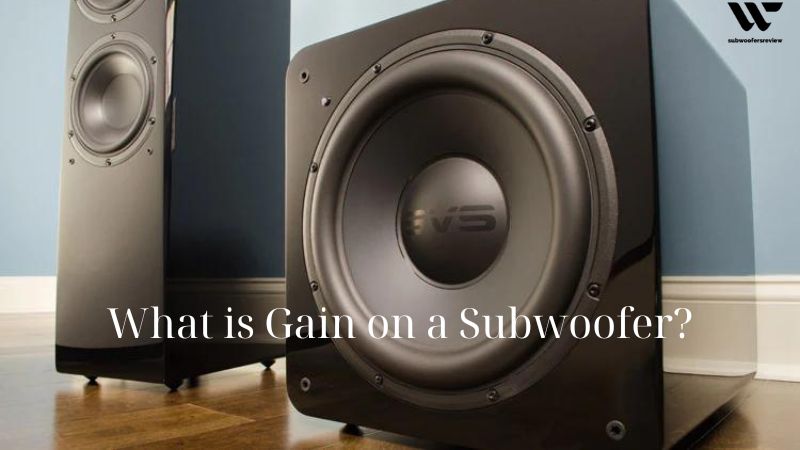Understanding the intricacies of audio systems can be a fascinating journey. Whether you’re an audiophile, a music enthusiast, or simply curious about the technical aspects of sound, one term that often comes up in discussions is “gain.” Gain plays a crucial role in shaping the output of a subwoofer, but what is gain on a subwoofer? and how does it affect the overall sound experience?
In this blog post, subwoofersreview will delve into the concept of gain on a subwoofer and explore its impact on the output. So, fasten your seatbelts and get ready for an enlightening exploration of the world of subwoofer gain!
What is Gain in Audio?
A home or automobile stereo system’s concept of gain is crucial. It speaks of the amplification of an audio signal. It can be used to change a component or signal’s volume control to match the volume of other components or signals in the system, resulting in a well-balanced audio output.
Gain is a metric used to describe how loud a receiver’s input volume is. In other words, gain is one of the variables that can be controlled for the input volume before these signals are processed.
It can be how loud the guitar is when it is playing before it enters the guitar amplifier. Another possibility is that the audio interface’s preamplified preamplified loudness is the issue. Alternately, it could be a volume that has already been recorded, but before it has been processed by a plugin.
Gain and Volume differ in that when you change the time, the input tone, color, and dynamic will also change. The frequency of a non-uniform signal may also fluctuate as a result.
By driving the circuit into which a voice or instrument is entering, gain allows us to change the sound of the voice or instrument, whereas volume control enables us to change the overall level of your audio without altering the tone.

What is Gain on a Subwoofer?
Performance of a subwoofer is greatly influenced by gain control. The subwoofer’s output level is influenced by the power supplied to it, which is what determines the quantity of power. A subwoofer cannot deliver the maximum amount of pressure if it is not powered sufficiently.
What is A Gain Control?
Two stages with distinct objectives can be used to represent an amplifier:
- Listen to the signal at the input stage.
- Create a louder signal at the output stage.
According to the optimal signal level, the power rating of an amplifier indicates how much power the output stage can send to your speakers. The input step enters the picture here.
It sounds simple to listen for a signal, right? It becomes challenging to manage various voltage levels coming from various input (source) components. How does an amplifier operate everywhere? Enter to take command.
Gain control’s main function is to modify the amplifier’s input stage so that it can accommodate the input device’s voltage level. Consider how a phone call would compare. As the person on the other end of the line, it is your responsibility to pay attention.
You can’t hear other people over the background noise nearby when the phone volume is too low. People around you will have trouble understanding you if the volume is cranked up too loud. It’s important to note that at this interval, your friend can speak at various volumes and still be understood.
Gain operates in a similar manner; if it is too low, background noise or “hissing” will dominate. Even at regular level, music gets distorted when it is set too loud. You can use different volume levels from your head unit without experiencing too much hissing or distortion, much like during a phone call.

You may also like: Deep Dive into Sound: How to Make a Subwoofer have More Bass
How does Gain Affect Subwoofer Performance?
Decrease of distortion at high volume
Low-end sounds can be reproduced more effectively and precisely thanks to the high gain. The main advantage of higher gain settings for subwoofers is that they can lessen distortion and create stronger bass performance at high levels.
This is due to the amplifier in the subwoofer’s ability to process music more powerfully, resulting in louder and clearer sound. By enabling the subwoofer to attain a wider frequency range, a proper volume setting can also boost the subwoofer’s capacity to accommodate lower bass notes.
Improved balance in the sound
Gain adjustment can result in a more balanced sound with better clarity and bottom response. Controlling the subwoofer signal’s volume is how this is accomplished. Bass that is overly loud and distorted will result from setting the gain too high, while bass that is muffled and weak will result from setting it too low.
The pressure is raised
You may turn up the volume and adjust the bass output when you set the sub’s loudness. In addition to filling the soundstage for good sound production, this can contribute to making listening more immersive. The trim levels can ensure that the bass output is snappy and detailed as opposed to being overly soft or explosive.
Improved handling of energy
Gain increases allow the speaker to output sound at larger volumes and with more clarity because the woofer’s power handling also increases. This is so that the subwoofer can withstand louder volumes without distorting the music. The gain factor increases the signal that is transmitted to the subwoofer in this way.
Even with fewer sources, the subwoofer may play audiophiles more effectively by increasing its sensitivity by setting the gain to maximum volume. The subwoofer’s efficiency can also be increased by lowering the power sent to it.

Wrapping Up
In conclusion, gain on a subwoofer refers to the level of amplification applied to the audio signal that is being sent to the subwoofer. It directly affects the output of the subwoofer, as increasing the gain can result in a louder and more powerful bass response.
However, it is important to use gain judiciously and find the right balance, as excessive gain can lead to distortion and potentially damage the subwoofer. Finding the optimal gain setting for your subwoofer can greatly enhance your audio experience and ensure that you are getting the best possible bass performance.

